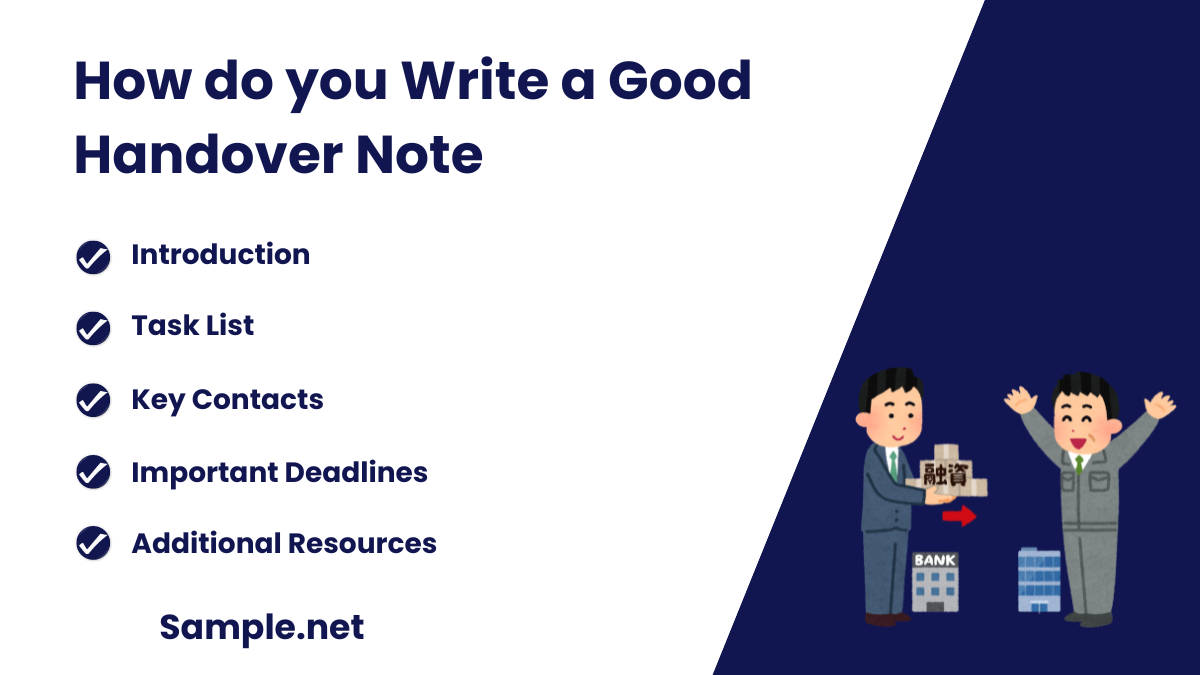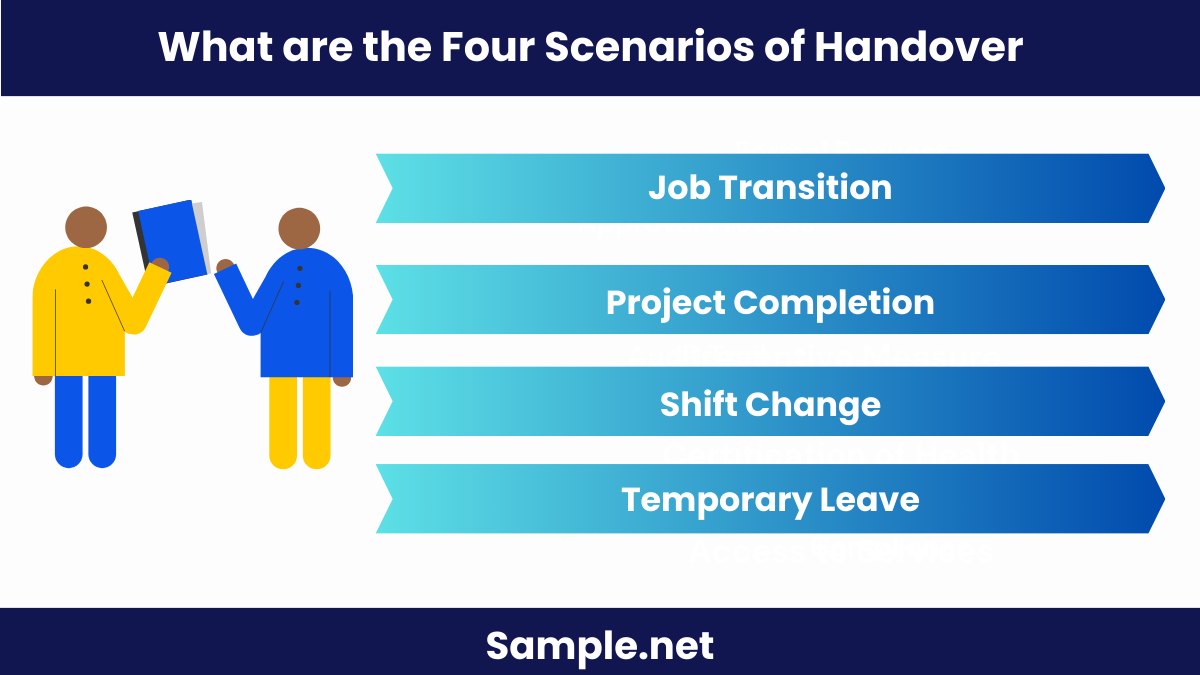Job Handover Note Samples
-

Simple Job Handover Note
download now -
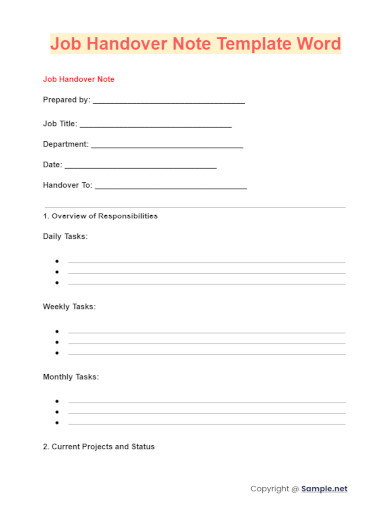
Job Handover Note Template Word
download now -

Handover Template When Leaving a Job
download now -
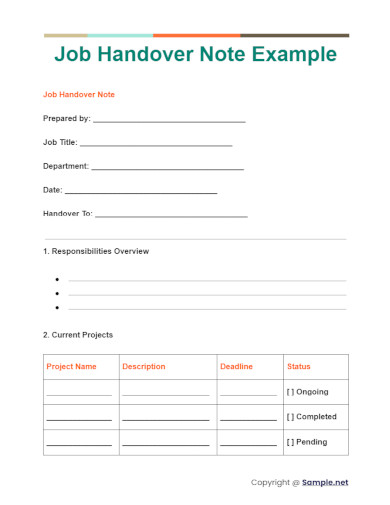
Job Handover Note Example
download now -
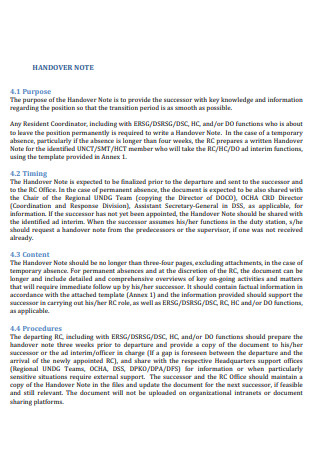
Job Handover Note
download now -
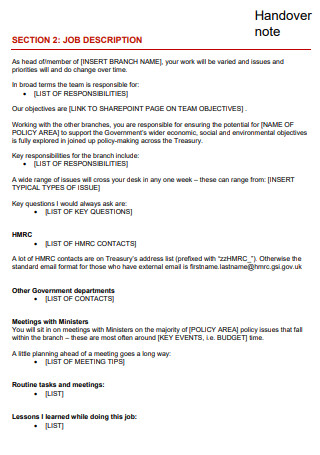
Job Description Handover Note
download now -
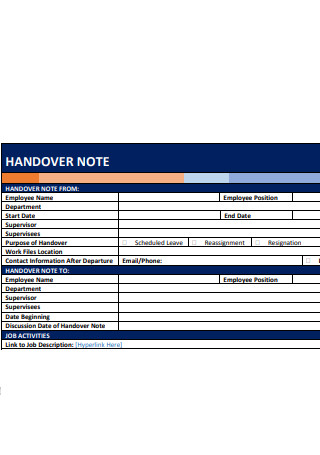
Job Activity Handover Note
download now -

Sample Job Handover Note
download now -
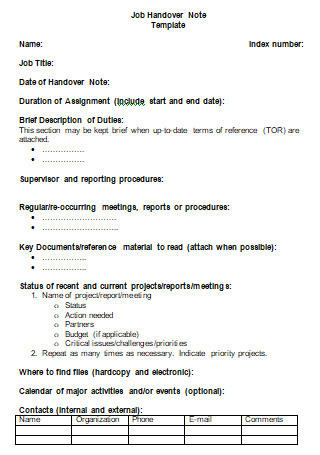
Standard Job Handover Note
download now -
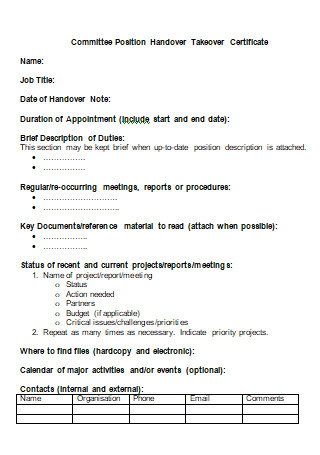
Committee Job Handover Certificate Note
download now -
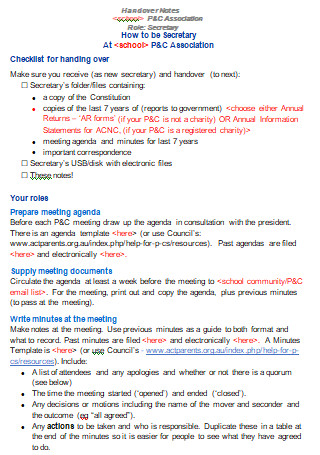
Secretary Job Handover Note
download now -
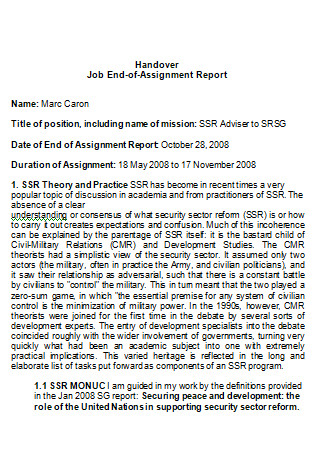
Job Assignment Handover Note
download now
FREE Job Handover Note s to Download
Job Handover Note Format
Job Handover Note Samples
What is Job Handover Note?
Things to Prepare Before Conducting a Project Handover
Tips to Improve Job Handovers
How to Write a Job Handover Note
Why have a good handover?
What problems can occur during handover?
What is a handover report?
How do you write a good handover note?
How do you write a short handover note?
Types of Handover Documentation
What are the four scenarios of handover?
What should be included in bedside handover?
What is a handover summary?
What are the handover notes for leaving a job?
What Is Handover Documentation?
What is a handover checklist?
How long should a handover be?
What are the two types of handover?
How do you initiate a handover process?
Download Job Handover Note Bundle
Job Handover Note Format
1. Title
- Job Handover Note
2. Handover Details
- Employee’s Name
- Job Title
- Department
- Date
3. Recipient Details
- New Employee’s Name
- Job Title
- Department
4. Handover Content
- Current Projects
- Outstanding Tasks
- Key Contacts
- Important Deadlines
5. Additional Information
- Access to Resources
- Relevant Documentation
6. Signatures
- Outgoing Employee’s Signature
- New Employee’s Signature
- Manager’s Signature
What is Job Handover Note?
A job handover note is a document that outlines the essential tasks, responsibilities, and information required to ensure a smooth transition when an employee leaves their position. It includes detailed instructions, key contacts, and important deadlines, providing a clear roadmap for the successor. This document helps maintain continuity and minimizes disruptions during the transition period.
Things to Prepare Before Conducting a Project Handover
Preparing a job handover document may be a challenging task if you are not as familiar with the process. Though if you have written it before, then this curated article will merely serve as a reminder for you. Employees who have not experienced composing a handover letter should utilize the list below as this will provide them with sufficient information on what goes into the preparation of a project handover. Keep in mind that you may not necessarily follow them at a precise point but you can refer to them from here and there.
Tips to Improve Job Handovers
Job handovers will take a significant amount of time as the transition may not immediately be completed in one sitting. Large projects will require the new recruit to learn the background of the project while also studying up on the role they will be fulfilling. With that being said, your role in the company or in the project itself can help them out to be more familiar. Learning how to successfully pass off a project might be difficult. Read on for professional advice on creating a successful job handover note and some extension, an efficient handover plan.
How to Write a Job Handover Note
To begin the handover process, discuss it with the outgoing employee, as they will be expected to outline their usual daily work tasks as well as any other vital information the new employee will need to know. The specific contents and duration of your job handover notes will be determined by the nature of your job and duties, as well as whether you are leaving the organization permanently or temporarily. Include information on what is needed to be known, details that can ensure a smooth transition, and relevant points in fulfilling the role. This will help to formulate the letter format. You may also see Nursing Notes
1. Prepare a Timetable of Actions and Deadlines
The first thing that you will need to do is to write out a description of the daily tasks and processes of the former or departing employee. That way, the future reader will be aware of what they will be fulfilling or carrying out in the future. You can assign your resigning employee to detail their day-to-day activities in a daily operation report to provide a more fleshed-out description of their actions. Additionally, you can include the project deadlines and status updates with each task so the reader will be aware of what to prioritize and what can be compromised. Any upcoming meetings should also be stated in a meeting notice so that the new employee can attend each and every one of them.
2. A Summary of Current Concerns and Useful Contacts
The next section will require you to come up with a list of any ongoing issues that can heavily impact the project if they were not acted upon. The provision of a list of key contacts is also relevant for this step. List out the customers, clients, stakeholders, and managers that play a significant role in the project. You can also input additional notes for the reader to be aware of what purpose they act in the project and how they can help to further the progress of the project. You may also see File Notes
3. Giving Access to Relevant Files
There may be company-specific programs that other people are not familiar with. This is where you will give them initial information on what to do for specific computer files or data. Insert in this section is a tutorial to access the computer system’s files and directories. It is important after all that they are able to access the important spreadsheets and files relating to the project. Unable to access these files can pose a threat to the completion of the project because certain data may be only found within these confidential files and are not open to anyone outside of the company. You may also see Return Delivery Note
4. Providing and Revoking Passwords and Login Information
Lastly, in connection to the former point, is to give out login information for the newer employee to have smoother access to the documents limited to those involved in the project. Oftentimes, files are password locked so make sure you have that added in the job handover note. You may also see Cornell Note
Why have a good handover?
Like a knowledge transfer plan, a proper handover will assist new team members in settling in fast and feeling more comfortable and confident with the processes of the new job. A thorough handover may also be highly useful to other employees and the organization as a whole since there will be considerably less interruption to team operations and productivity rates. Furthermore, when long-term team members leave an organization, there is always the danger of knowledge and expertise being lost. Handovers lessen that risk by assisting in the transfer of knowledge from the departing team member to the incoming recruit. You may also see Delivery Note Form
What problems can occur during handover?
A job or project handover will take a significant amount of time, especially if it is a large task that will be transferred from one departing employee to another newer one. In order to be prepared for the worst, the common problems you can encounter while performing a job handover are identified as follows. Insufficient system knowledge, a lack of disciplined knowledge, insufficient mode of communication, an inadequate provision of documentation, and complications in tracking changes are mere examples but not limited to them. Upon knowing these kinds of challenges, you can then plot ahead and prepare a handover checklist to combat them. You may also see Job Application Form
What is a handover report?
A handover report is a summary of activity that is frequently used in job sharing or temporary work assignments. It may also be handy when someone is leaving a position and turning over the reins to a new employee. In summary, a handover report allows one person to summarize their work for another employee who is taking over the position or project. When two employees change responsibilities, a handover report ensures that nothing crucial is neglected. Whether you’re stepping in for someone who is on vacation or taking over a new role entirely, there are major and little concerns that must be communicated to ensure a seamless transition. You may also see Job Handover Note
How do you write a good handover note?
Writing a good handover note ensures a smooth transition and continuity of work. Key steps include:
- Introduction: Start with a brief introduction of your role and responsibilities. Mention the purpose of the handover note.
- Task List: List all ongoing tasks and projects. Provide detailed descriptions and current status.
- Key Contacts: Include a list of important contacts and their roles. Mention who to reach out to for specific issues.
- Important Deadlines: Highlight any critical deadlines. Provide timelines and due dates for ongoing tasks.
- Additional Resources: Attach relevant documents like Doctor’s Note or Concept Notes. Include links to key resources and files.
How do you write a short handover note?
A short handover note should be concise yet informative. Key points include:
- Brief Introduction: Mention your role and the purpose of the note.
- Essential Tasks: List the most critical ongoing tasks with current status. You may also see Job Descriptions
- Key Contacts: Provide contact information for important team members.
- Immediate Deadlines: Highlight any urgent deadlines.
- Important Resources: Include links to essential documents and resources, such as Delivery Note.
Types of Handover Documentation
Different types of handover documentation serve various purposes. Key types include:
- Task Handover: Detailed list of ongoing tasks and their status. Ensures continuity of work.
- Project Handover: Comprehensive documentation of a project’s progress, milestones, and next steps. Similar to Promissory Note for projects.
- Role Handover: Detailed description of daily responsibilities and important contacts. Useful for role transitions.
- Client Handover: Information about client interactions, preferences, and ongoing issues. Ensures smooth client relationship management.
- Equipment Handover: Instructions and status reports on equipment and tools. Ensures proper maintenance and usage. You may also see Job Analysis
What are the four scenarios of handover?
Handover scenarios vary based on context. Key scenarios include:
- Job Transition: When an employee leaves or changes roles. Requires detailed task and contact information.
- Project Completion: Handover at the end of a project. Includes final reports and next steps.
- Shift Change: Used in shift-based work environments. Similar to SOAP Notes, detailing ongoing patient or task information.
- Temporary Leave: When an employee takes leave. Includes instructions for covering tasks and responsibilities. You may also see Job Report
What should be included in bedside handover?
A bedside handover ensures continuity of care in healthcare settings. Key elements include:
- Patient Information: Basic patient details like name and age.
- Current Condition: Brief update on the patient’s current status and recent changes.
- Ongoing Treatments: Details of treatments and medications being administered.
- Immediate Concerns: Any urgent issues or observations that need attention.
- Care Plan: Next steps in the patient’s care plan, including upcoming tests or procedures, similar to School Notes.
What is a handover summary?
A handover summary provides a brief overview of ongoing tasks, responsibilities, and key contacts to ensure a smooth transition, similar to an Intake Progress Note.
What are the handover notes for leaving a job?
Handover notes for leaving a job include details on current projects, important contacts, deadlines, and any pending tasks, akin to a Procedure Note.
What Is Handover Documentation?
Handover documentation consists of detailed records of duties, tasks, and processes handed over to a successor, similar to a Mental Health Progress Note.
What is a handover checklist?
A handover checklist ensures all critical tasks and information are covered during the transition, much like a Secured Promissory Note outlines key financial terms.
How long should a handover be?
A handover should be concise yet comprehensive, typically taking one to two weeks, ensuring all crucial information is transferred effectively, like a Meeting Note.
What are the two types of handover?
The two types of handover are task-based handovers and role-based handovers, each tailored to specific transitions, much like DAP Notes and Research Note formats.
How do you initiate a handover process?
Initiate a handover process by planning early, documenting all tasks, and coordinating with the successor, ensuring a smooth transition, similar to organizing Meeting Minutes & Meeting Notes.
In conclusion, a job handover note is crucial for ensuring a seamless transition in any role. By using sample notes, forms, and letters, you can create a comprehensive and effective handover document. This ensures that all necessary information is clearly communicated, reducing the risk of misunderstandings and maintaining operational continuity. A well-prepared job handover note, akin to a Job Contract, serves as a vital tool for both the departing employee and their successor, facilitating a smooth and efficient transition.


